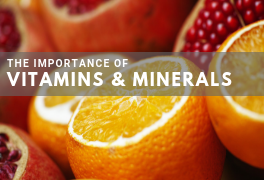23 Sep Vitamins and Minerals for Pain Management
 Our lifestyles and eating habits can have a big impact on our bodies. It should come as no surprise that chronic pain can also be impacted by how we fuel our bodies with food. Here are a few different ways that the foods you eat can have a good effect on your health and help fight inflammation and make pain more manageable.
Our lifestyles and eating habits can have a big impact on our bodies. It should come as no surprise that chronic pain can also be impacted by how we fuel our bodies with food. Here are a few different ways that the foods you eat can have a good effect on your health and help fight inflammation and make pain more manageable.
Nutrient insufficiencies
In the most recent 2015-2020 Dietary Guidelines for Americans many Americans fall short when it comes to meeting the recommended intake of vitamins and minerals. Let’s look at a few of those vitamins and minerals specifically related to pain.
- Magnesium: A magnesium deficiency could be causing problems or complications with headaches and muscle pain. Getting the recommended dosage of magnesium can help provide relief from premenstrual syndrome (PMS), fibromyalgia and other pain conditions. The recommended dosages per day are 400-600mg per day. The best food sources for magnesium include: nuts, spinach, dark leafy greens, bananas, dark chocolate, quinoa, fatty fish like salmon, brown rice and soy.
- Vitamin C: This vitamin is important for bone health and collagen generation, as well as antioxidation and removing of inflammation-causing markers in the body. Studies have shown that getting adequate Vitamin C in your diet may help alleviate pain in the spine, pancreatitis-related pain, cancer pain, and it may reduce the need for high dosages of pain medications. The recommended dosage is 500mg per day.The best food sources for Vitamin C include: citrus, broccoli, spinach, sweet potato and tomatoes.
- Alpha Lipoic Acid: This has been shown in recent studies to help with diabetic neuropathy. Dosages of up to 600mg per day have been shown beneficial with or without vitamin B12. The best food sources for Alpha Lipoic Acid include: nuts and seeds.
Sources
- (1)Gröber U, Schmidt J, Kisters K. Magnesium in prevention and therapy. Nutrients. 2015;7(9):8199- 8226. doi:10.3390/nu7095388
- (2) Dionne C, Laurin D, Desrosiers T, et al. Serum vitamin C and spinal pain: a nationwide study. Pain. 2016;157(11):2527-2535. doi:10.1097/ j.pain.0000000000000671
- (3) Carr AC, McCall C. The role of vitamin C in the treatment of pain: new insights. J Transl Med. 2017;15(1):77. doi:10.1186/s12967- 017-1179-7
- (4) Ahmed Ali U, Jens S, Busch OR, et al. Antioxidants for pain in chronic pancreatitis. Cochrane Database Syst Rev. 201;(8):CD008945. doi:10.1002/14651858.CD008945. pub2
- (5)Han Y, Wang M, Shen J, et al. Differential efficacy of methylcobalamin and alpha-lipoic acid treatment on negative and positive symptoms of (type 2) diabetic peripheral neuropathy. Minerva Endocrinol. 2016. https:// www.minervamedica.it/en/journals/ minerva-endocrinologica/article. php?cod=R07Y2018N01A0011
 For more information on The Pain Management Group, please visit thepainmanagementgroup.com or schedule an appointment at one of our locations throughout Middle Tennessee.
For more information on The Pain Management Group, please visit thepainmanagementgroup.com or schedule an appointment at one of our locations throughout Middle Tennessee.
We are committed to providing individualized care and vow to treat each patient with compassion and respect, never turning anyone away. Our physicians are fellowship-trained pain specialists who utilize a combination of interventional procedures and medication management services to tailor a personalized care plan for each patient’s long-term pain relief.




